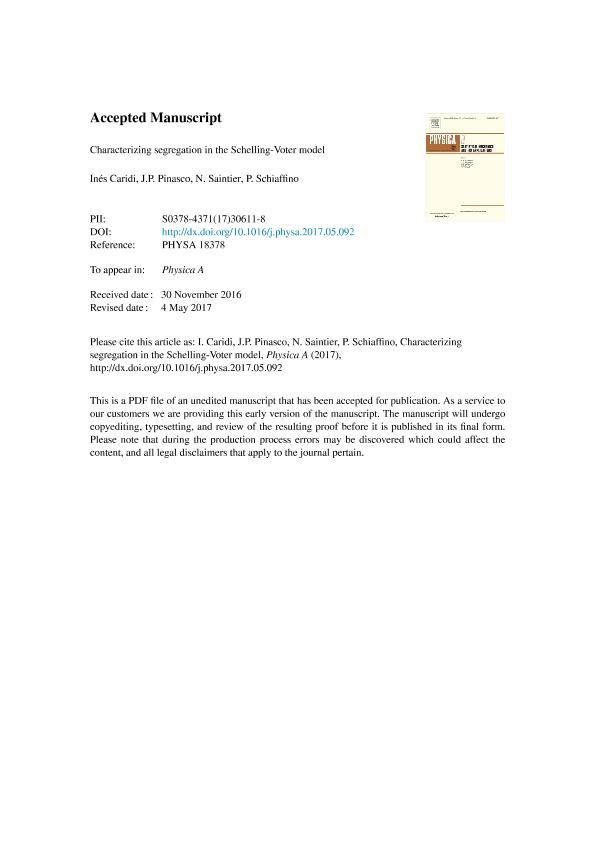Mostrar el registro sencillo del ítem
dc.contributor.author
Caridi, Délida Inés

dc.contributor.author
Pinasco, Juan Pablo

dc.contributor.author
Saintier, Nicolas Bernard Claude

dc.contributor.author
Schiaffino, Pablo

dc.date.available
2018-08-15T11:19:20Z
dc.date.issued
2017-12
dc.identifier.citation
Caridi, Délida Inés; Pinasco, Juan Pablo; Saintier, Nicolas Bernard Claude; Schiaffino, Pablo; Characterizing segregation in the Schelling–Voter model; Elsevier Science; Physica A: Statistical Mechanics and its Applications; 487; 12-2017; 125-142
dc.identifier.issn
0378-4371
dc.identifier.uri
http://hdl.handle.net/11336/55580
dc.description.abstract
In this work we analyze several aspects related with segregation patterns appearing in the Schelling–Voter model in which an unhappy agent can change her location or her state in order to live in a neighborhood where she is happy. Briefly, agents may be in two possible states, each one represents an individually-chosen feature, such as the language she speaks or the opinion she supports; and an individual is happy in a neighborhood if she has, at least, some proportion of agents of her own type, defined in terms of a fixed parameter T. We study the model in a regular two dimensional lattice. The parameters of the model are ρ, the density of empty sites, and p, the probability of changing locations. The stationary states reached in a system of N agents as a function of the model parameters entail the extinction of one of the states, the coexistence of both, segregated patterns with conglomerated clusters of agents of the same state, and a diluted region. Using indicators as the energy and perimeter of the populations of agents in the same state, the inner radius of their locations (i.e., the side of the maximum square which could fit with empty spaces or agents of only one type), and the Shannon Information of the empty sites, we measure the segregation phenomena. We have found that there is a region within the coexistence phase where both populations take advantage of space in an equitable way, which is sustained by the role of the empty sites.
dc.format
application/pdf
dc.language.iso
eng
dc.publisher
Elsevier Science

dc.rights
info:eu-repo/semantics/openAccess
dc.rights.uri
https://creativecommons.org/licenses/by-nc-nd/2.5/ar/
dc.subject
Crowds
dc.subject
Schelling Model
dc.subject
Segregation
dc.subject
Voter Model
dc.subject.classification
Matemática Pura

dc.subject.classification
Matemáticas

dc.subject.classification
CIENCIAS NATURALES Y EXACTAS

dc.title
Characterizing segregation in the Schelling–Voter model
dc.type
info:eu-repo/semantics/article
dc.type
info:ar-repo/semantics/artículo
dc.type
info:eu-repo/semantics/publishedVersion
dc.date.updated
2018-08-14T14:34:02Z
dc.journal.volume
487
dc.journal.pagination
125-142
dc.journal.pais
Países Bajos

dc.journal.ciudad
Amsterdam
dc.description.fil
Fil: Caridi, Délida Inés. Universidad de Buenos Aires. Facultad de Ciencias Exactas y Naturales. Instituto de Cálculo; Argentina
dc.description.fil
Fil: Pinasco, Juan Pablo. Consejo Nacional de Investigaciones Científicas y Técnicas. Oficina de Coordinación Administrativa Ciudad Universitaria. Instituto de Investigaciones Matemáticas "Luis A. Santaló". Universidad de Buenos Aires. Facultad de Ciencias Exactas y Naturales. Instituto de Investigaciones Matemáticas "Luis A. Santaló"; Argentina
dc.description.fil
Fil: Saintier, Nicolas Bernard Claude. Consejo Nacional de Investigaciones Científicas y Técnicas. Oficina de Coordinación Administrativa Ciudad Universitaria. Instituto de Investigaciones Matemáticas "Luis A. Santaló". Universidad de Buenos Aires. Facultad de Ciencias Exactas y Naturales. Instituto de Investigaciones Matemáticas "Luis A. Santaló"; Argentina
dc.description.fil
Fil: Schiaffino, Pablo. Universidad Torcuato Di Tella; Argentina
dc.journal.title
Physica A: Statistical Mechanics and its Applications

dc.relation.alternativeid
info:eu-repo/semantics/altIdentifier/url/https://www.sciencedirect.com/science/article/pii/S0378437117306118
dc.relation.alternativeid
info:eu-repo/semantics/altIdentifier/doi/https://doi.org/10.1016/j.physa.2017.05.092
Archivos asociados
